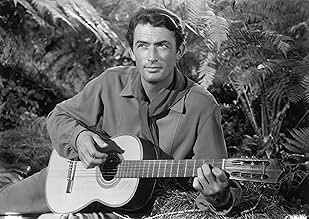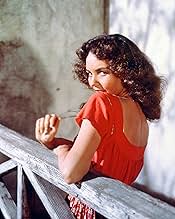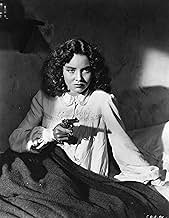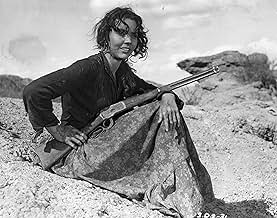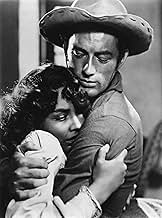CALIFICACIÓN DE IMDb
6.7/10
10 k
TU CALIFICACIÓN
La hermosa mestiza Pearl Chávez se convierte en pupilo del primer amor de su padre muerto y se encuentra dividida entre los hijos de esta, uno bueno y el otro malo.La hermosa mestiza Pearl Chávez se convierte en pupilo del primer amor de su padre muerto y se encuentra dividida entre los hijos de esta, uno bueno y el otro malo.La hermosa mestiza Pearl Chávez se convierte en pupilo del primer amor de su padre muerto y se encuentra dividida entre los hijos de esta, uno bueno y el otro malo.
- Nominado a 2 premios Óscar
- 3 premios ganados y 4 nominaciones en total
Griff Barnett
- The Bordertown Jailer
- (sin créditos)
John Barton
- Party Guest
- (sin créditos)
Opiniones destacadas
This movie is like a painting by an old master that hangs in a museum--we may not be moved by it, but we can still appreciate the artistry. Its most notable feature is the director, King Vidor, master of silent film making. As you might expect, many of the important scenes have little or no dialog. In one scene between Lionel Barrymore and Lillian Gish, he rambles on about their life together, while she strains to get out of her sickbed and crosses slowly to him, the entire distance transfigured by the depth of her love for him. Gish was a great star of silent film, with a wonderful, expressive face, full of compassion and grace. In another scene that happens under quite different circumstances, Jennifer Jones crawls to Gregory Peck, the man she loves, also without words, evincing great sorrow and quiet dignity. In both cases, the women prove they are far more noble than the men who love them so badly. Jones also has a mobile face, together with a beautiful, resonant voice. No film that has these two ladies at its center should be missed. In addition, the film has two marvelous scenes that, at the time of its making, would have been just as impressive as some of today's special effects wonders: In the first, about 20 armed horsemen face a crowd of railway workers, including some chinese, clothed in authentic period dress, with a steam engine in the background. As the tensions mount, a troop of mounted cavalry, about 100 strong, ride onto the set, filmed on location (judging by the saguarros and ocatillos) in Arizona. This was a tour de force of filmmaking at a time when shooting on location was rare. In the second scene, a train under a full head of steam jumps the tracks and plows down an embankment. Filmed in early technicolor, this movie has lush exteriors and panoramas of rich desert color. Two more character actors should be mentioned, both of whom steal every scene they enter: Butterfly McQueen, the maid whose comments are both simple and profound, and Walter Huston, as the crusty sheriff who doubles as a preacher during a funeral.
Well, it's obvious that Selznick was trying his best to recapture that GWTW magic...but this is an unbelievably inept failure. Here's what you can expect from this overblown sex-western:
--Jennifer Jones (in pancake make-up so orange that she put me more in mind of an Oompa-Loompa than the half-breed we're supposed to see) apparently directed to act as though she's Scarlett O'Hara with a lobotomy and bad grammar.
--Gregory Peck as rogue murdering rapist and the apple of his daddy's eye. At one point even doing a pretty decent vocal imitation of Clark Gable -- too bad it's just the voice.
--Lionel Barrymore lazily repeating his "It's a Wonderful Life" role from the same year -- wheelchair & grumpiness standing in for effort.
--Butterfly McQueen as kerchiefed ditzy maid. Hmmm, wonder where they got that idea?
All in all, a miserable movie experience. You'd think that since they cribbed from the best it'd have turned out better! Go figure.
--Jennifer Jones (in pancake make-up so orange that she put me more in mind of an Oompa-Loompa than the half-breed we're supposed to see) apparently directed to act as though she's Scarlett O'Hara with a lobotomy and bad grammar.
--Gregory Peck as rogue murdering rapist and the apple of his daddy's eye. At one point even doing a pretty decent vocal imitation of Clark Gable -- too bad it's just the voice.
--Lionel Barrymore lazily repeating his "It's a Wonderful Life" role from the same year -- wheelchair & grumpiness standing in for effort.
--Butterfly McQueen as kerchiefed ditzy maid. Hmmm, wonder where they got that idea?
All in all, a miserable movie experience. You'd think that since they cribbed from the best it'd have turned out better! Go figure.
David O. Selznick spent the rest of his life trying to top Gone With the Wind. What other mountains did he have to climb after making the most acclaimed motion picture ever?
In addition he had another obsession, his second wife Jennifer Jones. He was going to make her the greatest leading lady in the history of film.
Well he didn't succeed at either, but it wasn't for lack of trying. Jones herself was in a peculiar position similar to her husband's. She got an Oscar for her first feature film after she changed her name from Phyllis Isley to Jennifer Jones. Selznick knew that she couldn't play saints all her life as she did in The Song of Bernadette. So for this western answer to Gone With the Wind as Pearl Chavez she plays about as opposite a character from Bernadette Soubirous as you can get.
Duel in the Sun got mixed reviews by the critics, but the public ate it up. It's the story of the McCanless family, parents Lionel Barrymore and Lillian Gish and sons Joseph Cotten and Gregory Peck. Cotten is the good son, Peck the bad one. In fact as Lewt McCanless Peck played his worst character until Josef Mengele in Boys from Brazil.
A kissing cousin of their's Jennifer Jones comes to live with them. She's the offspring of an old beau of Lillian's, Herbert Marshall and the Indian wife he ran off with back in the day. Lillian and Herbert were kissing cousins also.
As Pearl Chavez, Jen gets the McCanless boys testosterone going into overdrive. Take one look at her and you can hardly blame them.
One of the not so hidden subtexts of Duel in the Sun is racism. Jennifer's good for a quick roll in the hay, but marriage is out of the question, at least for Gregory Peck. Barrymore's and Peck's racism is overt, the others not quite so, but it's still there.
The negotiations with Louis B. Mayer for Lionel Barrymore must have been interesting. Selznick's former wife was Irene Mayer, Louis's daughter.
One thing with Selznick, he spared no expense. He got the best in talent for this film. Dimitri Tiomkin did the score, King Vidor the direction, Ray Rennahan the color photography which is absolutely stunning.
He even got Bing Crosby to record Gotta Get Me Somebody to Love with Les Paul's guitar. Peck sang it in the film, Crosby's record sold a few platters.
He even got Orson Welles to do the off-screen narration if you don't recognize that voice.
It misses being a classic mainly because Selznick couldn't keep his hands off it. Sometimes the acting is about as subtle as a sledgehammer from all the performers. I'm willing to bet it's Selznick more than Vidor.
Yet it's good entertainment and Duel in the Sun does have its moments.
In addition he had another obsession, his second wife Jennifer Jones. He was going to make her the greatest leading lady in the history of film.
Well he didn't succeed at either, but it wasn't for lack of trying. Jones herself was in a peculiar position similar to her husband's. She got an Oscar for her first feature film after she changed her name from Phyllis Isley to Jennifer Jones. Selznick knew that she couldn't play saints all her life as she did in The Song of Bernadette. So for this western answer to Gone With the Wind as Pearl Chavez she plays about as opposite a character from Bernadette Soubirous as you can get.
Duel in the Sun got mixed reviews by the critics, but the public ate it up. It's the story of the McCanless family, parents Lionel Barrymore and Lillian Gish and sons Joseph Cotten and Gregory Peck. Cotten is the good son, Peck the bad one. In fact as Lewt McCanless Peck played his worst character until Josef Mengele in Boys from Brazil.
A kissing cousin of their's Jennifer Jones comes to live with them. She's the offspring of an old beau of Lillian's, Herbert Marshall and the Indian wife he ran off with back in the day. Lillian and Herbert were kissing cousins also.
As Pearl Chavez, Jen gets the McCanless boys testosterone going into overdrive. Take one look at her and you can hardly blame them.
One of the not so hidden subtexts of Duel in the Sun is racism. Jennifer's good for a quick roll in the hay, but marriage is out of the question, at least for Gregory Peck. Barrymore's and Peck's racism is overt, the others not quite so, but it's still there.
The negotiations with Louis B. Mayer for Lionel Barrymore must have been interesting. Selznick's former wife was Irene Mayer, Louis's daughter.
One thing with Selznick, he spared no expense. He got the best in talent for this film. Dimitri Tiomkin did the score, King Vidor the direction, Ray Rennahan the color photography which is absolutely stunning.
He even got Bing Crosby to record Gotta Get Me Somebody to Love with Les Paul's guitar. Peck sang it in the film, Crosby's record sold a few platters.
He even got Orson Welles to do the off-screen narration if you don't recognize that voice.
It misses being a classic mainly because Selznick couldn't keep his hands off it. Sometimes the acting is about as subtle as a sledgehammer from all the performers. I'm willing to bet it's Selznick more than Vidor.
Yet it's good entertainment and Duel in the Sun does have its moments.
PURE OPERA. From the scenic backdrops seething in passionate colors to Jennifer Jones' over-ripe performance and Dimitri Tiomkin's tempestuous score...'Duel In The Sun' isn't just another soapy oater, it is the ultimate soapy oater. Brimming with more bad taste than any screenwriter could possibly misconceive, this Selznick classic is the penultimate guilty viewing pleasure...if you like you're Westerns on the sleazy side that is!
The performances are all unapologetically over-the-top, with Ms. Jones, in an Oscar winning performance no less, as Pearl Chavez, the 'half-breed' vixen torn between lust for Gregory Peck's Lewt McCanles, the bad-boy brother gone badder, and the 'save-me-from-myself' brand of love for Joseph Cotten's Jesse McCanles, the good brother with not-a-whole-heck-of-alot of sex appeal going for him. In between all this indecision, Ms. Jones sets fire to the scenery with as many sultry leers and poses as, I suppose, the censors of the time would permit her. "I'm TRASH, TRASH, TRASH," Pearl exclaims. And that about sums it all up. In spades! I should also make mention of the other Oscar winning performance, that by the venerable Lillian Gish as Laura Belle McCanles who, in perhaps the most painfully rapturous sequence, resurrects her silent film training in a tour-de-force of physical acting that, in less capable hands, would only be embarrassing. Not that you won't be tempted to laugh mind you, even Grand Opera, at the best of times, isn't this exquisitely sublime. And then there is Butterfly McQueen...as the befuddled maid (what else)...in the only role written for obvious comedic effect, whose long-winded sincerity couldn't be the more perfect foil for a hurried house full of whitees with nothing but sex on the brain...
On the technical side, it is an unquestionably ravishing film to look at. In glorious Technicolor, the 'Old West' never looked more mythic or more prone to tragedy...the 'campy' side that is. And, yet once more, Dimitri Tiomkin finesses our ears with a resounding melody of wide open spaces and of still bigger ambitions and desires, culminating in a symphonic tempest for two ill-fated (or over-sexed) lovers who could only be united in death.
WOW, this picture is right off the Harlequin Romance map! And I enjoyed every minute of it.
The performances are all unapologetically over-the-top, with Ms. Jones, in an Oscar winning performance no less, as Pearl Chavez, the 'half-breed' vixen torn between lust for Gregory Peck's Lewt McCanles, the bad-boy brother gone badder, and the 'save-me-from-myself' brand of love for Joseph Cotten's Jesse McCanles, the good brother with not-a-whole-heck-of-alot of sex appeal going for him. In between all this indecision, Ms. Jones sets fire to the scenery with as many sultry leers and poses as, I suppose, the censors of the time would permit her. "I'm TRASH, TRASH, TRASH," Pearl exclaims. And that about sums it all up. In spades! I should also make mention of the other Oscar winning performance, that by the venerable Lillian Gish as Laura Belle McCanles who, in perhaps the most painfully rapturous sequence, resurrects her silent film training in a tour-de-force of physical acting that, in less capable hands, would only be embarrassing. Not that you won't be tempted to laugh mind you, even Grand Opera, at the best of times, isn't this exquisitely sublime. And then there is Butterfly McQueen...as the befuddled maid (what else)...in the only role written for obvious comedic effect, whose long-winded sincerity couldn't be the more perfect foil for a hurried house full of whitees with nothing but sex on the brain...
On the technical side, it is an unquestionably ravishing film to look at. In glorious Technicolor, the 'Old West' never looked more mythic or more prone to tragedy...the 'campy' side that is. And, yet once more, Dimitri Tiomkin finesses our ears with a resounding melody of wide open spaces and of still bigger ambitions and desires, culminating in a symphonic tempest for two ill-fated (or over-sexed) lovers who could only be united in death.
WOW, this picture is right off the Harlequin Romance map! And I enjoyed every minute of it.
No need to recap the plot.
One thing about this overblown fandango— once seeing it, you won't forget it. How could anyone when everything is done to such tasteless excess. Poor Pearl (Jones). Apparently, Jones was told her part was that of a hot-blooded wench, which she unfortunately took to mean parboiled. It's hard not to laugh at the first hour when she acts like a nympho on steroids, tossing hair and leering wildly like pampas grass in a windstorm. Not far behind is that vintage ham Lionel Barrymore doing his usual blustery bit, like we won't get his hard-bitten patriarch unless he takes it into hyper speed. And who could have guessed that the usually constricted and constrained Gregory Peck could actually over-act. I think it was his first and last time—good thing, too.
It's possible to go on about the unrelenting excess— the sunsets that appear to hemorrhage, a musical score that's as necessary as sugar on molasses, and a loony ending that defies parody. But you get the idea. Too bad so much money and effort went into such a generally overheated result. Only Cotten, Gish and the black stallion come through unscathed. I'm thinking RKO could have made a dozen worthwhile programmers on the same budget. As things turned out, Selznick did his beloved Jones no favors with this one. It's hard to believe the man responsible for Gone with the Wind (1939) is also responsible for this swollen mess.
One thing about this overblown fandango— once seeing it, you won't forget it. How could anyone when everything is done to such tasteless excess. Poor Pearl (Jones). Apparently, Jones was told her part was that of a hot-blooded wench, which she unfortunately took to mean parboiled. It's hard not to laugh at the first hour when she acts like a nympho on steroids, tossing hair and leering wildly like pampas grass in a windstorm. Not far behind is that vintage ham Lionel Barrymore doing his usual blustery bit, like we won't get his hard-bitten patriarch unless he takes it into hyper speed. And who could have guessed that the usually constricted and constrained Gregory Peck could actually over-act. I think it was his first and last time—good thing, too.
It's possible to go on about the unrelenting excess— the sunsets that appear to hemorrhage, a musical score that's as necessary as sugar on molasses, and a loony ending that defies parody. But you get the idea. Too bad so much money and effort went into such a generally overheated result. Only Cotten, Gish and the black stallion come through unscathed. I'm thinking RKO could have made a dozen worthwhile programmers on the same budget. As things turned out, Selznick did his beloved Jones no favors with this one. It's hard to believe the man responsible for Gone with the Wind (1939) is also responsible for this swollen mess.
¿Sabías que…?
- TriviaAccording to King Vidor, director Josef von Sternberg was hired only as a lighting expert by David O. Selznick in order to give his wife--and the film's star--Jennifer Jones a more glamorous look.
- ErroresThe opening shows saguaro cacti in the valley. The film is supposed to take place in Texas, but southern Arizona is the only place in the US with saguaro cacti, unless they've been transplanted.
- Citas
The Sinkiller: Under that heathen blanket, there's a full-blossomed woman built by the devil to drive men crazy.
- Versiones alternativasThe original "roadshow" version ran 144 minutes. The additional 16 minutes, over the commonly-shown 128 minute version, consisted of a musical "prelude," an "overture" (which contained a spoken prologue, by Orson Welles), and exit music, but no additional scenes in the film. The two additional opening sequences were each inadvertently given the other's label.
- ConexionesEdited into Histoire(s) du cinéma: Une histoire seule (1989)
Selecciones populares
Inicia sesión para calificar y agrega a la lista de videos para obtener recomendaciones personalizadas
Detalles
- Fecha de lanzamiento
- País de origen
- Idioma
- También se conoce como
- Duel in the Sun
- Locaciones de filmación
- Productoras
- Ver más créditos de la compañía en IMDbPro
Taquilla
- Presupuesto
- USD 8,000,000 (estimado)
- Total en EE. UU. y Canadá
- USD 20,408,163
- Total a nivel mundial
- USD 20,428,771
- Tiempo de ejecución2 horas 26 minutos
- Relación de aspecto
- 1.37 : 1
Contribuir a esta página
Sugiere una edición o agrega el contenido que falta

Principales brechas de datos
By what name was Duelo al sol (1946) officially released in India in English?
Responda




